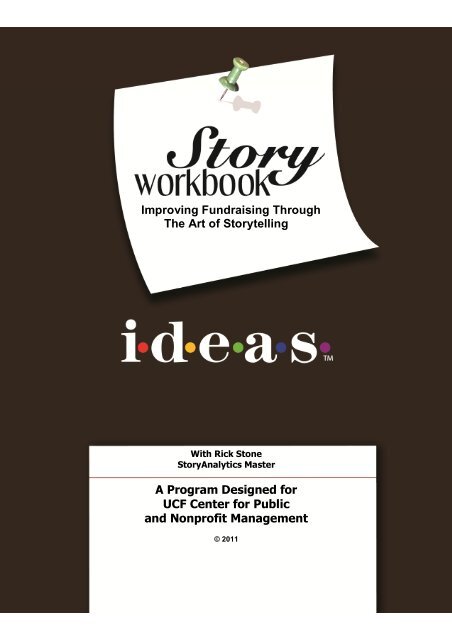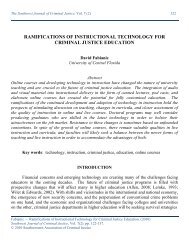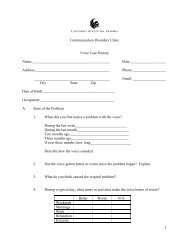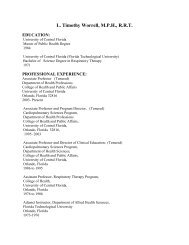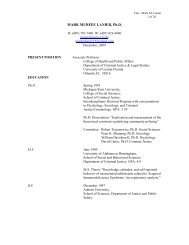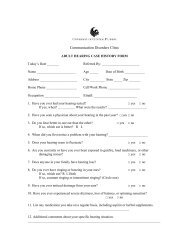SCCFP The Art of Story Telling
SCCFP The Art of Story Telling
SCCFP The Art of Story Telling
Create successful ePaper yourself
Turn your PDF publications into a flip-book with our unique Google optimized e-Paper software.
Improving Fundraising Through<br />
<strong>The</strong> <strong>Art</strong> <strong>of</strong> <strong>Story</strong>telling<br />
With Rick Stone<br />
<strong>Story</strong>Analytics Master<br />
A Program Designed for<br />
UCF Center for Public<br />
and Nonpr<strong>of</strong>it Management<br />
© 2011
How to Find and Use Stories for<br />
Fundraising<br />
1. In your many years <strong>of</strong> experience with your organization, you have<br />
undoubtedly had a wide array <strong>of</strong> experiences that potentially could become<br />
powerful fundraising stories. Here’s a series <strong>of</strong> questions that may prompt you to<br />
remember events and anecdotes that can be turned into usable stories:<br />
a) What has been your organization’s biggest setback, and how did you<br />
overcome or solve the problem?<br />
b) Who are the people in your organization that you admire the most? Why?<br />
c) Which <strong>of</strong> your staff members has impressed you the most? Why? What have<br />
they done to win your admiration and respect?<br />
d) What stories have you heard within the organization that made the biggest<br />
impression?<br />
e) What is the most outstanding story that you have ever heard that expresses<br />
your mission and values?<br />
2. Your co-workers can also be a source <strong>of</strong> important stories which you<br />
can add to your organization’s repertoire. First, to find these stories requires that<br />
your staff knows that you’re in the market for a good tale that illustrates an<br />
important organizational value and involves some degree <strong>of</strong> heroism. Second,<br />
ask each <strong>of</strong> your staff members, from secretary on up, if they have a good story<br />
for you. And, on a regular basis seek new stories. It’s a good way to stay in<br />
contact with all your staff.<br />
3. If someone brings a story to you that’s usable, write up the story and<br />
distribute it around the <strong>of</strong>fice. It’s a great way to recognize the hero <strong>of</strong> the<br />
story as well as reinforce your organization’s values, vision, and concerns.
How to Create a Good <strong>Story</strong><br />
<strong>The</strong>re are many things to consider when taking a raw experience and turning it<br />
into a teaching story that can be told and shared with others. First <strong>of</strong> all, you<br />
must establish the time <strong>of</strong> the story in order to facilitate transporting your<br />
audience to a different world, with different values, and a different place. For<br />
example, “When I was a boy, my father and I set out on a trip across the<br />
country in our old Model T Ford . . . .” Or, “When I worked in the Sarasota <strong>of</strong>fice,<br />
there was another technician named Jeb Smith. I never met anyone more<br />
committed to getting the job done right. In fact, once he . . . .”<br />
It’s also important to establish the place <strong>of</strong> the story and the personalities<br />
involved. And what’s the mood <strong>of</strong> the story, e.g., distant, intimate, humorous,<br />
wishful, fanciful, suspenseful, etc? Also, to turn good anecdotes into stories that<br />
can enable learning requires that you convey events through conversations and<br />
actions rather than straight narration. Here are a few suggestions:<br />
1. Start with a dramatic opening or an heroic deed. Few listeners can resist<br />
a story with a good beginning.<br />
2. <strong>The</strong> best teaching stories are usually true. Try to verify your facts.<br />
3. Expand on the anecdote and develop it into an extended story. But keep it<br />
succinct and short, something you could tell in two or three minutes.<br />
4. Try to have your story illustrate one theme or idea.<br />
5. Have your story unfold according to events, not explanations descriptions<br />
or summations.<br />
6. Keep plot details simple and easy to remember.<br />
7. Remember that a character is best revealed through his or her actions.<br />
Also, use real names.<br />
8. Remember that the story itself is the important thing—let events speak for<br />
themselves.
9. Give the anecdote an ending that satisfies the listener’s sense <strong>of</strong> justice.<br />
Give it a good title.<br />
10. Project the image like a film in your imagination.<br />
11. Share the story with a friend or colleague and evaluate what worked<br />
and why. What didn’t work? Why?<br />
12. Refine the story based on these evaluations.
Creating a Good <strong>Story</strong>, continued<br />
<strong>Story</strong> Development as Dictation<br />
When we write or develop a story for telling, it should feel like taking dictation.<br />
Some may think <strong>of</strong> this as being seized by the inspiration <strong>of</strong> the Muses, or<br />
centering in the heart, or relaxing into a state <strong>of</strong> heightened creativity. Whatever<br />
it’s called, the experience is characterized by listening, alertness and receptivity,<br />
an awareness <strong>of</strong> entering into relation with something greater than our conscious<br />
will. In this sense, we don’t have to make ourselves write as much as let<br />
ourselves write. Whatever this something greater is, it is the source from which<br />
the vision, the understanding, and the words finally flow. Developing a story,<br />
then, is more an act <strong>of</strong> following than leading, the vocation not <strong>of</strong> the<br />
demagogue but <strong>of</strong> the scribe.<br />
<strong>The</strong> <strong>Story</strong>’s Predicament is the Material for a Good <strong>Story</strong><br />
A story has a precipitating event, a conflict, a resolution <strong>of</strong> conflict, and a point.<br />
But what precipitating event? Which conflict, and how to resolve it? And what is<br />
the point? Whatever form the story takes, it must be imbued with the life you or<br />
the story’s contributors know, the life that has moved you or them to this point,<br />
or it most assuredly will not move the reader. You don’t need to fabricate drama.<br />
Every life has drama; the gift you can bring to the story is to discern this drama<br />
and expand, accentuate, and articulate it in an edifying way.<br />
Conflict: An Essential Ingredient<br />
A story needs a through-line that's anchored in a central conflict or predicament.<br />
This conflict should build, as opposed to being random or episodic. Someone<br />
<strong>of</strong>fered this formula for plot structure: Get a hero. Get the hero up a tree. Throw<br />
rocks at the hero. Throw bigger rocks at the hero. Get the hero out <strong>of</strong> the tree.<br />
<strong>The</strong> resolution <strong>of</strong> the conflict (hero comes out <strong>of</strong> tree) gives the story a climax.
Without a through-line, a story wanders aimlessly, somewhere between the<br />
living and the dead. Without conflict that builds, the emotional impact is as flat<br />
as last year's seltzer. Come from somewhere. Go somewhere. Make a lot <strong>of</strong><br />
trouble along the way. Get there.<br />
At the Heart <strong>of</strong> Things: <strong>The</strong> Universal in the Particular<br />
<strong>The</strong> art <strong>of</strong> developing or writing a story is a matter <strong>of</strong> vision—specifically, the<br />
ability to recognize the universal in the particular. Imagine being almost run over<br />
by an ambulance that came tearing down the country road. <strong>The</strong> ambulance<br />
could represent, in a sense, the double-edged sword <strong>of</strong> technology. How ironic it<br />
is irony that the very things that we depend on to save us may end up killing us.<br />
Can you see how this “point” goes even beyond the context <strong>of</strong> technology, to a<br />
farther reaching import. This is a good example <strong>of</strong> the universal in the particular.<br />
Because the universal resides in the particular (holographically), your<br />
predicament is your material, and if you can make your vision coherent enough,<br />
like the laser light used to create a hologram, you will discern the universal<br />
theme or themes in your particular experience, or that <strong>of</strong> someone whose story<br />
you are creating. You have to learn to listen for the truth currents coursing<br />
through people’s experiences. A good story beats with its own life; it has heart,<br />
rhythm. You find this rhythm by looking honestly and willingly at the here and<br />
now, and reporting what you see with as little judgment or censorship as<br />
possible. Forget all the l<strong>of</strong>ty and “important” ideas and words. In this sense, all<br />
good writing is journalism, even if it takes the form <strong>of</strong> poetry, fiction, an essay, a<br />
screenplay, or a children’s book. <strong>The</strong> life you or someone else really lives moves<br />
through what you write or tell, which is why it can move your readers, leaving<br />
them glad that they read what you wrote. Listen for this heartbeat while you’re<br />
writing, and keep true to its simple rhythm, always moving forward, on to the<br />
next beat. Don’t let yourself get stalled in images or judgments about “writing”
or “the truth.” “<strong>The</strong> truth” is not the truth. Real truth—the truth that touches the<br />
reader because it conveys something universally human—is always at the “heart<br />
<strong>of</strong> the matter,” which means always in the relevant particulars. From this angle<br />
<strong>of</strong> vision, everything is mirror and metaphor.<br />
<strong>The</strong> <strong>Story</strong> is Contained in the Details<br />
Forget about grand ideas. Don't give me pr<strong>of</strong>ound; give me valuable detail.<br />
Focus on the nervous tic <strong>of</strong> your math teacher in the third grade. Or the way you<br />
used to cook corn right out <strong>of</strong> the field in an open fire on your uncle's farm—the<br />
way that smelled. Or the fear <strong>of</strong> waiting for test results from the lab and being<br />
put on hold for three minutes. Once you're on track with the details, the<br />
particulars <strong>of</strong> experience, see if you can arrange them to capture something<br />
universal. <strong>The</strong> framing <strong>of</strong> the valuable particulars so as to convey the universal is<br />
the art <strong>of</strong> writing. Valuable detail is the key, as distinct from meaningless<br />
trivialities that don't contribute to the general sense <strong>of</strong> direction and purpose <strong>of</strong><br />
the piece. Avoid the "fly on the salt shaker" syndrome. Find a balance between<br />
grandiosity (macroscopic) and irrelevant detail (microscopic) to hold the reader.<br />
<strong>The</strong> <strong>Story</strong>’s Structure<br />
Every story has a premise. For example, what would happen to the use <strong>of</strong> the<br />
internet if the government decided to tax all transactions as well as place a tax<br />
on every email that is sent? This could lead to a story reminiscent <strong>of</strong> the Boston<br />
tea party, or could go down very different imaginal pathways. A good story also<br />
has a beginning, a middle, and an end.<br />
<strong>The</strong> Beginning, or the Precipitating Event: Something happens to launch the<br />
series <strong>of</strong> events that unfold in the forward motion <strong>of</strong> the story (plot). This event<br />
should be identified early in the piece. In a short story, usually the first few<br />
paragraphs establish the precipitating event or situation, sometimes the first few
lines. It can be subtle, a precipitating psychological shift, or more obvious,<br />
triggering some external change. This is called the “beginning.”<br />
<strong>The</strong> Middle, or Character Arc: <strong>The</strong> Precipitating Event sets into motion a chain <strong>of</strong><br />
causes and effects that carry the protagonist seamlessly through some significant<br />
change or changes. This is called the “middle.” In this sense, the main character<br />
is a living map <strong>of</strong> the plot, the medium in which the story is humanly impressed.<br />
If a character does not “arc,” does not go through some important change, the<br />
story is likely to leave the reader flat.<br />
<strong>The</strong> End, or Resolution: Resolution does not mean that everything gets wrapped<br />
up neatly in a forced conclusion that leaves the reader without questions or<br />
wonder. Resolution does mean that the vision being presented, the premise, the<br />
theme, the point, have been presented fully. Resolution will rarely be<br />
philosophically or morally conclusive, but will instead <strong>of</strong>fer a dramatic conclusion.<br />
This is an important difference. While dramatic resolution brings the conflict to<br />
completion, it also may raise questions for the reader that remain unanswered by<br />
the piece. When the writer does this skillfully, she has come upon the part <strong>of</strong> the<br />
story called the “end.” It is important to recognize this and not write past it.<br />
Plot<br />
Don’t let plot bury your story.<br />
What Plot is Not. . .<br />
• a series <strong>of</strong> essentially unrelated episodes or scenes<br />
• fragments that create mood or stir the senses but lack focus and direction<br />
• anything gratuitous: sex, humor, weirdness, violence, intellectuality, character<br />
quirkiness, drama.<br />
• arbitrary conflicts—with or without resolutions—that don't serve a larger
context <strong>of</strong> conflict and resolution.<br />
What Plot is. . .<br />
• through line<br />
• the story's sense <strong>of</strong> its own identity<br />
• confident, decisive forward motion the thread that strings the dramatic beads<br />
<strong>of</strong> the story together<br />
• a meaning-arc that gives the reader a sense <strong>of</strong> closure and completion<br />
• the soul <strong>of</strong> the story (words are the body)<br />
Capturing the Reader’s Attention<br />
If it’s a written story, it is essential to bring the reader into the story right away,<br />
to create a world with an emotional atmosphere and gravity that puts the<br />
reader's feet on the earth <strong>of</strong> what you have to say. Without this, he or she won't<br />
care a whit about your characters or their dilemmas. Detail, to lay a claim on the<br />
reader, has to be honest.<br />
Heart-honest. Relevant. Rooted. It has to point somewhere and stay true to<br />
itself. This somewhere is a compass heading you never abandon.<br />
Some Pointers:<br />
Good writing is built on the power and beauty <strong>of</strong> economy. As Churchill said,<br />
“Use the shortest word that will do the job.” Don't WRITE, just write. No purple<br />
prose, no neon twilights. Simplify. Experiment with underwriting. As the saying<br />
goes, “Less is more.” Believe it.<br />
Identify in a single sentence, the theme or point to your story. If you can't state<br />
it clearly in a sentence, you're not ready to start writing. <strong>The</strong> idea may change,<br />
evolve during the writing. Often your characters will redirect you. Still, have a<br />
good idea <strong>of</strong> where you want to go before pulling out <strong>of</strong> the driveway.
Language is music, which means that good writing doesn't just “say,” it “plays.”<br />
Short, staccato sentences convey suspense. Long, winding sentences carry the<br />
reader along and draw him in gently and gradually. Experiment with the rhythms<br />
and cadences <strong>of</strong> your native tongue. Mix up sentence length. Feel the emphasis,<br />
the punctuation, the rim-shots and violin passages <strong>of</strong> a phrase. Play with this,<br />
and keep it all simple.
How to Learn and Tell a <strong>Story</strong><br />
1. Learn the plot first. Fix in your mind the major sequence <strong>of</strong> events.<br />
Visualize the events, the scenes, the characters.<br />
2. If it helps, write out the story first, in outline or finished form. Your<br />
<strong>Story</strong> Prompter sheet can provide all the information you need to map out the<br />
story in preparation for telling.<br />
3. Some people find it helpful to create a storyboard <strong>of</strong> the main action in order<br />
to better learn the sequence <strong>of</strong> events. We call this “comic strip memory.”<br />
Take two 8½ X 11 sheets <strong>of</strong> paper and using both the front and back divide<br />
each side into four squares. You’ll have sixteen total squares. In each block<br />
draw small stick figure sketches <strong>of</strong> the major scenes. In this way you will be<br />
able to see the story from beginning to end in just a glance, and you will<br />
have developed iconic or picture images in your brain that are easier to<br />
remember than verbal or scripted forms.<br />
4. Try telling the story in rough form, using your own words, and not paying<br />
attention to details, and the smoothness <strong>of</strong> telling. Do this with a friend,<br />
colleague, or into a tape recorder. It sometimes helps to record the story<br />
verbatim on a tape player and listen to it several times before attempting to<br />
learn it. Keep your rough storyboard in front <strong>of</strong> you, and glance at it from<br />
time to time if you need help remembering where you are in the story. Ask<br />
your partner for feedback at the conclusion. (Below are some suggestions for<br />
how to give feedback. You may want to coach your telling partner in how to<br />
give constructive feedback before you begin.)<br />
5. <strong>The</strong>re are no prescribed ways to tell a story. <strong>The</strong> same story can be told<br />
many different ways, all effectively. A lot depends upon your audience. I<br />
recommend that you experiment to find what is both most comfortable for<br />
you and best fits your own personal style; and, what is best received by your<br />
audience.
6. Start <strong>of</strong>f at a walking pace. That way you’ve got room to speed up and slow<br />
down, as the story requires. Loudness, or s<strong>of</strong>tness <strong>of</strong> voice, can be used for<br />
emphasis at times, in addition to changing the pace or interjecting pauses,<br />
but don’t overuse it.<br />
7. After getting feedback you might want to cut out certain parts <strong>of</strong> the story<br />
and embellish other parts. A rule <strong>of</strong> thumb is to cut tedious lengthy<br />
descriptions <strong>of</strong> thoughts or emotions. Use metaphors to describe emotions<br />
instead <strong>of</strong> technical, psychological words. Those parts that your listener<br />
particularly enjoyed, stretch out. Notice which sections <strong>of</strong> the story need<br />
further development. Avoid side-trips unless they add suspense or help to<br />
paint the picture <strong>of</strong> an important character.<br />
Guidelines for Feedback:<br />
1. Give positive, specific feedback about: Parts <strong>of</strong> the story you liked and<br />
the parts that you thought were very clear; and, ways the person told the<br />
story, e.g., their voice tone, use <strong>of</strong> eye contact, use <strong>of</strong> appropriate emotion,<br />
etc.<br />
2. Ask for clarity on points you didn’t understand. For example, “I didn’t<br />
understand what happened when . . . .”<br />
3. Suggest parts they might want to cut or stretch.
Making Your Organization’s Mission & Values Real<br />
In the space on the next page, list out your organization’s mission and stated<br />
values. If there are some implicit values that are not visibly articulated, list those<br />
as well.<br />
Now, choose one <strong>of</strong> those values and think <strong>of</strong> a story about yourself or someone<br />
else in the organization that as fully as possible expresses the essence <strong>of</strong> that<br />
value. In a moment, you’ll have a chance to share that story.<br />
Now, take a few moments to think <strong>of</strong> a story for each <strong>of</strong> the values. In the space<br />
below the value, write a brief logline that will help you remember the story for<br />
future telling.<br />
In the movie business, a logline is a short phrase or sentence that works as a<br />
shorthand to describe a story. Your logline answers the question: What is your<br />
story about? Here are three questions to ask yourself as you write your logline:<br />
Who is the main character and what does he or she want?<br />
Who or what was standing in the way <strong>of</strong> the main character?<br />
What makes this story unique?<br />
Here are a few examples:<br />
Value—service; Logline: An hourly employee <strong>of</strong> our organization drove<br />
100 miles on her day <strong>of</strong>f to ensure that a family would have their<br />
child’s medication.<br />
Value—innovation; Logline: On her own time, and without permission<br />
<strong>of</strong> her manager who would have disapproved, Sally Blake spent her<br />
lunch hours developing an electronic bypass to allow patients to<br />
securely access their own medical records.
My organization’s mission, values and<br />
stories<br />
Mission:__________________________________________________________<br />
Logline:__________________________________________________________<br />
_________________________________________________________________<br />
_________________________________________________________________<br />
_________________________________________________________________<br />
Value:____________________________________________________________<br />
Logline:__________________________________________________________<br />
_________________________________________________________________<br />
_________________________________________________________________<br />
_________________________________________________________________<br />
Value:____________________________________________________________<br />
Logline:__________________________________________________________<br />
_________________________________________________________________<br />
_________________________________________________________________<br />
_________________________________________________________________<br />
Value:____________________________________________________________<br />
Logline:__________________________________________________________<br />
_________________________________________________________________<br />
_________________________________________________________________<br />
_________________________________________________________________<br />
Value:____________________________________________________________<br />
Logline:__________________________________________________________<br />
_________________________________________________________________<br />
_________________________________________________________________<br />
_________________________________________________________________<br />
Value:____________________________________________________________<br />
Logline:__________________________________________________________<br />
_________________________________________________________________<br />
_________________________________________________________________<br />
_________________________________________________________________
Your Organization’s Angels & Heroes<br />
List 5 angels or heroes below who have made a difference for your organization<br />
and the people you serve. Now, choose one <strong>of</strong> those angels or heroes and think<br />
<strong>of</strong> a story about that person and how they made a difference for someone else.<br />
In a moment, you’ll have a chance to share that story.<br />
Now, take a few moments to think <strong>of</strong> a story for each <strong>of</strong> your angels or heroes.<br />
In the space below their name, write a brief logline that will help you remember<br />
the story for future telling.<br />
Angel 1: __________________________________________________________<br />
Logline:___________________________________________________________<br />
_________________________________________________________________<br />
_________________________________________________________________<br />
_________________________________________________________________<br />
Angel 2: __________________________________________________________<br />
Logline:___________________________________________________________<br />
_________________________________________________________________<br />
_________________________________________________________________<br />
_________________________________________________________________<br />
Angel 3: __________________________________________________________<br />
Logline:___________________________________________________________<br />
_________________________________________________________________<br />
_________________________________________________________________<br />
_________________________________________________________________<br />
Angel 4: __________________________________________________________<br />
Logline:___________________________________________________________<br />
_________________________________________________________________<br />
_________________________________________________________________<br />
_________________________________________________________________<br />
Angel 5: __________________________________________________________<br />
Logline:___________________________________________________________<br />
_________________________________________________________________<br />
_________________________________________________________________<br />
_________________________________________________________________
Understanding Your Audience<br />
Who are the key audiences that you must be aware <strong>of</strong> when you go out into<br />
your community to deliver your message? What story are they living in? Can you<br />
broadly describe each <strong>of</strong> these audiences?<br />
Audience 1: ______________________________________________________<br />
_________________________________________________________________<br />
Audience 2: ______________________________________________________<br />
_________________________________________________________________<br />
Audience 3: ______________________________________________________<br />
_________________________________________________________________<br />
Audience 4: ______________________________________________________<br />
_________________________________________________________________<br />
In the space below identify an individual from one <strong>of</strong> those audiences who could<br />
potentially be a strong supporter <strong>of</strong> your organization. Give them a name. What<br />
are their key concerns and why does the work <strong>of</strong> your organization make a<br />
difference to them. What is it about a specific story that you might tell that<br />
would resonate with their story and background?<br />
Write 2 to 3 paragraphs. Be sure to tell us about this individual and helps us<br />
understand why they’d want to help. (use the back if necessary)
Matching Stories to Your Audience<br />
Now, consider each <strong>of</strong> your audiences and which story you tell best meets their<br />
pr<strong>of</strong>ile, needs, and background, and is most likely to motivate them to support<br />
your organization.<br />
Audience 1: ______________________________________________________<br />
_________________________________________________________________<br />
_________________________________________________________________<br />
<strong>Story</strong> Logline: _____________________________________________________<br />
_________________________________________________________________<br />
_________________________________________________________________<br />
_________________________________________________________________<br />
Audience 2: ______________________________________________________<br />
_________________________________________________________________<br />
_________________________________________________________________<br />
<strong>Story</strong> Logline: _____________________________________________________<br />
_________________________________________________________________<br />
_________________________________________________________________<br />
_________________________________________________________________<br />
Audience 3: ______________________________________________________<br />
_________________________________________________________________<br />
_________________________________________________________________<br />
<strong>Story</strong> Logline: _____________________________________________________<br />
_________________________________________________________________<br />
_________________________________________________________________<br />
_________________________________________________________________<br />
Audience 4: ______________________________________________________<br />
_________________________________________________________________<br />
_________________________________________________________________<br />
<strong>Story</strong> Logline: _____________________________________________________<br />
_________________________________________________________________<br />
_________________________________________________________________<br />
_________________________________________________________________
Notes & Ideas<br />
________________________________________________________________________<br />
________________________________________________________________________<br />
________________________________________________________________________<br />
________________________________________________________________________<br />
________________________________________________________________________<br />
________________________________________________________________________<br />
________________________________________________________________________<br />
________________________________________________________________________<br />
________________________________________________________________________<br />
________________________________________________________________________<br />
________________________________________________________________________<br />
________________________________________________________________________<br />
________________________________________________________________________<br />
________________________________________________________________________<br />
________________________________________________________________________<br />
________________________________________________________________________<br />
________________________________________________________________________<br />
________________________________________________________________________<br />
________________________________________________________________________<br />
________________________________________________________________________<br />
________________________________________________________________________<br />
________________________________________________________________________<br />
________________________________________________________________________<br />
________________________________________________________________________<br />
________________________________________________________________________<br />
________________________________________________________________________<br />
________________________________________________________________________<br />
________________________________________________________________________
Notes & Ideas<br />
________________________________________________________________________<br />
________________________________________________________________________<br />
________________________________________________________________________<br />
________________________________________________________________________<br />
________________________________________________________________________<br />
________________________________________________________________________<br />
________________________________________________________________________<br />
________________________________________________________________________<br />
________________________________________________________________________<br />
________________________________________________________________________<br />
________________________________________________________________________<br />
________________________________________________________________________<br />
________________________________________________________________________<br />
________________________________________________________________________<br />
________________________________________________________________________<br />
________________________________________________________________________<br />
________________________________________________________________________<br />
________________________________________________________________________<br />
________________________________________________________________________<br />
________________________________________________________________________<br />
________________________________________________________________________<br />
________________________________________________________________________<br />
________________________________________________________________________<br />
________________________________________________________________________<br />
________________________________________________________________________<br />
________________________________________________________________________<br />
________________________________________________________________________<br />
________________________________________________________________________<br />
________________________________________________________________________
Notes & Ideas<br />
________________________________________________________________________<br />
________________________________________________________________________<br />
________________________________________________________________________<br />
________________________________________________________________________<br />
________________________________________________________________________<br />
________________________________________________________________________<br />
________________________________________________________________________<br />
________________________________________________________________________<br />
________________________________________________________________________<br />
________________________________________________________________________<br />
________________________________________________________________________<br />
________________________________________________________________________<br />
________________________________________________________________________<br />
________________________________________________________________________<br />
________________________________________________________________________<br />
________________________________________________________________________<br />
________________________________________________________________________<br />
________________________________________________________________________<br />
________________________________________________________________________<br />
________________________________________________________________________<br />
________________________________________________________________________<br />
________________________________________________________________________<br />
________________________________________________________________________<br />
________________________________________________________________________<br />
________________________________________________________________________<br />
________________________________________________________________________<br />
________________________________________________________________________<br />
________________________________________________________________________<br />
________________________________________________________________________
Notes & Ideas<br />
________________________________________________________________________<br />
________________________________________________________________________<br />
________________________________________________________________________<br />
________________________________________________________________________<br />
________________________________________________________________________<br />
________________________________________________________________________<br />
________________________________________________________________________<br />
________________________________________________________________________<br />
________________________________________________________________________<br />
________________________________________________________________________<br />
________________________________________________________________________<br />
________________________________________________________________________<br />
________________________________________________________________________<br />
________________________________________________________________________<br />
________________________________________________________________________<br />
________________________________________________________________________<br />
________________________________________________________________________<br />
________________________________________________________________________<br />
________________________________________________________________________<br />
________________________________________________________________________<br />
________________________________________________________________________<br />
________________________________________________________________________<br />
________________________________________________________________________<br />
________________________________________________________________________<br />
________________________________________________________________________<br />
________________________________________________________________________<br />
________________________________________________________________________<br />
________________________________________________________________________<br />
________________________________________________________________________
64 E. Concord St.<br />
Orlando, FL 32801<br />
407-601-7878<br />
rstone@ideasorlando.com<br />
www.ideasorlando.com


